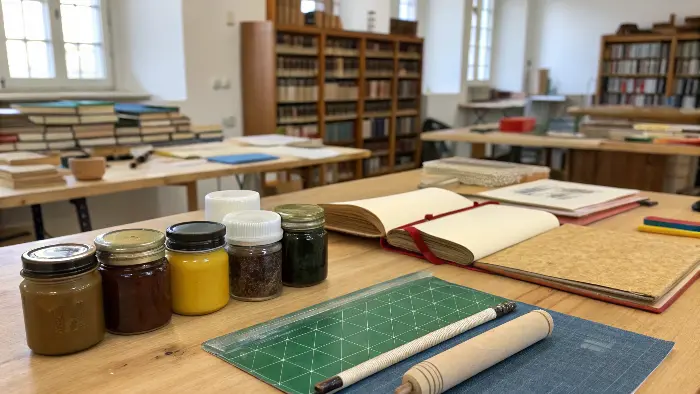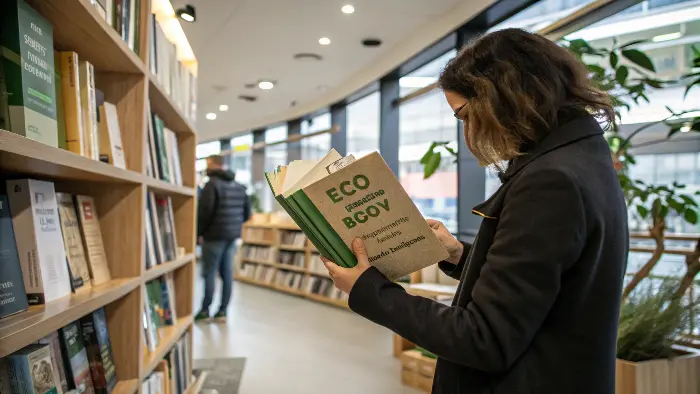Worried about publishing’s impact? Traditional books use harsh materials. But greener, high-quality options exist, making your books beautiful and responsible.
Eco-friendly book production uses sustainable materials like recycled paper, plant-based inks, and eco-conscious binding. This reduces waste, conserves resources, and minimizes harmful chemicals, offering a greener choice for everyone.
This is a big topic, I know! But stick with me. We’re going to break it down piece by piece. I’ve spent a lot of time at Panoffices digging into this because, frankly, it’s important. So, let’s dive in and explore how we can make books that are kinder to our planet, without skimping on quality or style. You might be surprised by what’s possible.
What Sustainable Materials Can We Use For Book Covers Instead of Traditional Ones?
Are book covers harming our planet? Old ways use too many resources. Luckily, new eco-materials offer style and sustainability for your books.
For eco-friendly book covers, consider materials like natural fibers (cotton, linen, hemp), recycled leather, cork, or even biodegradable plastics. These alternatives reduce reliance on virgin resources and harmful production.
Let’s really get into this. When I first started looking into greener options for Panoffices, the sheer range of materials for covers was surprising! Think about it – a book cover is the first thing people see and touch. Traditional covers often use virgin paper coated with plastic laminates, or synthetic leathers that are pretty resource-intensive. It’s a bit of a mess, environmentally speaking. But now? We’ve got some amazing alternatives.
Natural fiber fabrics like cotton, linen, or even hemp are becoming super popular. They offer a tactile, premium feel, and you know, they just feel good. Then there’s recycled leather – it uses leather scraps that would otherwise go to waste, giving you that luxe leather look without the full environmental footprint of new leather. I saw a sample book with a recycled leather cover the other day, and honestly, I couldn’t tell the difference from new! Cork is another fantastic one; it’s harvested from bark without harming the tree, super lightweight, and has this unique, warm texture. And for projects needing something more like plastic – say, for durability – biodegradable plastics or plant-based polymers are emerging. They break down much faster than traditional plastics. It’s not just about looking good; it’s about making a conscious choice that aligns with brand values – something buyers like Michael are increasingly looking for. It’s a game-changer, really.
How Can We Make Inks and Glues in Bookbinding More Eco-Friendly?
Do hidden toxins lurk in your books? Standard inks and glues can be nasty. But cleaner, greener options ensure safer, sustainable publishing now.
To make inks and glues eco-friendly, choose soy or vegetable-based inks over petroleum-based ones. For adhesives, opt for water-based or natural glues that are non-toxic and biodegradable.

Okay, so we’ve talked covers. But what about what holds the pages together and what prints the words? I mean, inks and glues are fundamental, right? For years, the standard was petroleum-based inks and synthetic adhesives, which, let’s be honest, aren’t great for the planet. They can release VOCs (Volatile Organic Compounds) – nasty stuff – and often contain heavy metals. Not ideal if you’re trying to be green.
But the good news is, the shift towards eco-friendlier options here is massive. Soy-based or vegetable-based inks are a fantastic alternative. They come from renewable resources, have lower VOC emissions, and can even make paper easier to de-ink for recycling. I remember when we first trialed some veggie inks at Panoffices for a client’s notebook line; the colors were just as vibrant, and the print team actually preferred working with them! For glues, water-based adhesives or even natural glues derived from starches are way better. They are generally non-toxic and biodegradable. The key, as I see it, is minimizing chemical waste and ensuring that what we use can return to the earth without causing harm. It’s these details that really add up to a truly sustainable product. It just makes sense.
Are There Greener Binding Techniques Beyond Just Materials?
Is your book’s binding eco-guilty? Some methods use excess waste and energy. Discover greener techniques for truly sustainable book construction today!
Yes! Greener binding includes methods like singer-sewn binding, which uses minimal thread, or mechanical bindings (spiral, wire-o) that allow for easy disassembly and recycling. Also, choose local binding to cut transport emissions.

This is where things get interesting because it’s not just what we use, but how we put it all together. You know? Traditional binding methods, especially perfect binding, can use a lot of strong, sometimes less-than-eco-friendly hot-melt glues. And if a book is heavily glued with that stuff, it can be harder to recycle because separating the paper from the spine adhesive is a real pain. I’ve seen recycling plants struggle with it.
So, what are the greener alternatives? Well, sewn bindings, like Smyth-sewn or even simpler singer-sewn (great for thinner books or booklets), are amazing. They use thread – often cotton or linen – and the book lays flatter, which is a nice bonus. Plus, they are incredibly durable. I’ve seen some beautiful notebooks with exposed Coptic stitch binding – it’s an art form in itself and uses minimal adhesive, sometimes none on the spine itself! For other types of publications, like reports or workbooks, mechanical bindings like spiral or wire-o can be a good choice, especially if you use recycled metal or bio-plastics for the coils. The big advantage there is that they can be easily disassembled for recycling – pages out, coil in the metal bin. Simple! And here’s a thought I always push: localizing your binding process. If you print in one place and bind far away, the carbon footprint from transportation adds up quickly. Reducing that makes a difference too! It’s about thinking holistically, from start to finish.
Why Should Stationery Buyers Like Michael Actually Care About Sustainable Book Production?
Think eco-books are just a fad? Buyers ignoring sustainability risk losing customers. See why green production is now a business must-have.
Buyers like Michael should care because consumers demand sustainable products. Eco-friendly books enhance brand image, meet European regulations, and can even offer long-term cost savings, appealing to eco-conscious markets.

Now, let’s bring this home for someone like Michael, an experienced product development manager working for a European stationery brand. Why should he push for these eco-friendly options? It’s not just about feeling good, though that’s part of it; it’s smart business. Seriously. First off, consumer demand in Europe for sustainable products is HUGE and growing every single day. People want to know where their stuff comes from and how it’s made. An eco-friendly stationery line isn’t just a niche anymore; it’s rapidly becoming mainstream. Aligning with this trend boosts brand reputation and loyalty – and who doesn’t want loyal customers?
Secondly, regulations. The European Green Deal, for example, is a big driver. Compliance with environmental standards is increasingly stringent. Being ahead of the curve with sustainable sourcing and production methods saves a ton of headaches later on. Think about material traceability or chemical restrictions – it’s better to be prepared. Thirdly, it can even lead to innovation in design and materials, creating unique selling points that make products stand out. And while some eco-materials might seem a tad pricier upfront, efficient processes, reduced waste, and appeal to premium markets can often balance that out, or even make it more profitable in the long run. For Michael, partnering with a supplier like Panoffices, who understands these nuances and can deliver quality, customizable, and sustainable stationery, is a massive win. It’s about future-proofing his brand. This isn’t just a trend, believe me, it’s the future.
Conclusion
Making books greener is totally doable! With smart material choices and better binding, we create beautiful, sustainable products. It’s a win for everyone.

